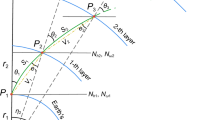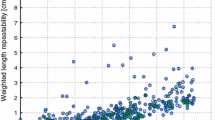Abstract
Three-dimensional ray tracing through a numerical weather model has been applied to a global precise point positioning (PPP) campaign for modeling both the elevation angle- and azimuth-dependence of the tropospheric delay. Rather than applying the ray-traced slant delays directly, the delay has been parameterized in terms of slant factors, which are applied in a similar manner to traditional mapping functions, but which can account for the azimuthal asymmetry of the delay. Five strategies are considered: (1) Vienna Mapping Functions 1 (VMF1) and estimation of a residual zenith delay parameter; (2) VMF1, estimation of a residual zenith delay and estimation of two tropospheric gradient parameters; (3) three-dimensional ray-traced slant factors and estimation of a residual zenith delay; (4) using only ray-traced slant factors and no estimation of any tropospheric parameters and; (5) using both ray-traced slant factors and estimating a residual zenith delay and two tropospheric gradient parameters. The use of the ray-traced slant factors (solution 3) showed a 3.8% improvement in the repeatability of the up component when compared to the assumption of a symmetric atmosphere (solution 1), while the estimation of two tropospheric gradient parameters gave the best results showing an 7.6% improvement over solution 1 in the up component. Solution 4 performed well in the horizontal domain, allowing for sub-centimeter repeatability but the up component was degraded due to deficiencies in the modeling of the zenith delay, particularly for stations located at equatorial latitudes. The magnitude of the differences in the mean coordinates between solution 2 and solution 3, and the strong correlation with the differences between the north component and the ray-traced gradients (coefficient of correlation of 0.83), as well as the impact of observation geometry on the gradient solution indicate that the use of the ray-traced slant factors could have an implication on the realization of reference frames. The estimated tropospheric products from the PPP solutions were compared to those derived from ray tracing. For the zenith delay, a root mean square (RMS) of 5.4 mm was found, while for the gradient terms, a correlation coefficient of 0.46 for the N–S and 0.42 for the E–W was found for the north–south and east–west components, suggesting that there are still important differences in the gradient parameters which could be due to either errors in the NWM or to non-tropospheric error sources leaking into the PPP-estimated gradients.
Similar content being viewed by others
References
Blewitt G (1989) Carrier phase ambiguity resolution for the Global Positioning System applied to geodetic baselines up to 2000 km. J Geophys Res 94(B8): 10187–10203. doi:10.1029/JB094iB08p10187
Boehm J, Schuh H (2003) Vienna Mapping Functions. In: Proceedings of the 16th Working Meeting on Eropean VLBI for Geodesy and Astrometry, Bundesamt für Kartographie und Geodäsie, Frankfurt/Leipzig, Germany, pp 131–144
Boehm J, Schuh H (2007) Troposphere gradients from the ECMWF in VLBI analysis. J Geod 81(6): 403–408. doi:10.1007/s00190-007-0144-2
Tregoning P, Schuh H (2006a) Global Mapping Function (GMF): A new empirical mapping function based on numerical weather model data. Geophys Res Lett 33: L07304. doi:10.1029/2005GL025546
Boehm J, Werl B, Schuh H (2006b) Troposphere mapping functions for GPS and very long baseline interferometry from European Centre for Medium-Range Weather Forecasts operational analysis data. J Geophys Res 111: B02406. doi:10.1029/2005JB003629
Chen G, Herring TA (1997) Effects of atmospheric azimuth asymmetry on the analysis of space geodetic data. J Geophys Res 102(B9): 20489–20502. doi:10.1029/97JB01739
COMET-UCAR (2007a) GEM global model overview. Cooperative Program for Operational Meteorology, Education and Training (COMET), http://www.meted.ucar.edu/nwp/pcu2/GEM-global/gemglob_overview.htm. Accesssed 31 Dec 2010
COMET-UCAR (2007b) Ten common misconceptions. Cooperative Program for Operational Meteorology, Education and Training (COMET), http://www.meted.ucar.edu/norlat/-tencom/p02.htm. Accesssed 31 Dec 2010
Côté J, Gravel S, Méthot A, Patoine A, Roch M, Staniforth A (1998) The operational CMC–MRB Global Environmental Multiscale (GEM) model. Part I: Design considerations and formulation. Mon Weather Rev 126(6): 1373–1395. doi:10.1175/1520-0493(1998)126<1373:TOCMGE>2.0.CO;2
Davis JL, Herring TA, Shapiro II, Rogers AEE, Elgered G (1985) Geodesy by radio interferometry: effects of atmospheric modeling errors on estimates of baseline length. Radio Sci 20(6): 1593–1607. doi:10.1029/RS020i006p01593
Dow J, Neilan R, Rizos C (2009) The International GNSS Service in a changing landscape of global navigation satellite systems. J Geod 83: 191–198. doi:10.1007/s00190-008-0300-3
Ghoddousi-Fard R, Dare P (2007) A climatic based asymmetric mapping function using a dual radiosonde raytracing approach. In: Proceedings of the 20th International Technical Meeting of the Satellite Division of the Institute of Navigation—ION GNSS 2007, The Institute of Navigation, Fort Worth, Texas, pp 2870–2879
Ghoddousi-Fard R, Dare P, Langley R (2009) Tropospheric delay gradients from numerical weather prediction models: effects on GPS estimated parameters. GPS Solut 13(4): 281–291. doi:10.1007/s10291-009-0121-8
Gradinarsky L, Haas R, Elgered G, Johansson J (2000) Wet path delay and delay gradients inferred from microwave radiometer, GPS and VLBI observations. Earth Planets Space 52(10): 695–698
Hobiger T, Ichikawa R, Koyama Y, Kondo T (2008a) Fast and accurate ray-tracing algorithms for real-time space geodetic applications using numerical weather models. J Geophys Res 113(D20). doi:10.1029/2008JD010503
Hobiger T, Ichikawa R, Takasu T, Koyama Y, Kondo T (2008) Ray-traced troposphere slant delays for precise point positioning. Earth Planets Space 60(5): e1–e4
Hobiger T, Ichikawa R, Koyama Y, Kondo T (2009) Computation of troposphere slant delays on a GPU. IEEE Trans Geosci Remote Sens 47(10): 3313–3318. doi:10.1109/TGRS.2009.2022168
Hobiger T, Shimada S, Ichikawa R, Koyama Y, Kondo T (2010) Improving GPS positioning estimates during extreme weather situations by the help of fine mesh numerical weather models. J Atmos Sol Terr Phys 72(2–3): 262–270. doi:10.1016/j.jastp.2009.11.018
Kouba J, Héroux P (2001) Precise point positioning using IGS orbit and clock products. GPS Solut 5(2): 12–28. doi:10.1016/S1464-1895(01)00103-X
Leandro R, Santos M, Langley R (2010) Analyzing GNSS data in precise point positioning software. GPS Solut 15(1): 1–13. doi:10.1007/s10291-010-0173-9
MacMillan D, Gipson J (2009) Recent modeling improvements in solve analysis. In: 19th European VLBI for Geodesy and Astronomy Working Meeting, Bordeaux, FR
MacMillan DS (1995) Atmospheric gradients from very long baseline interferometry observations. Geophys Res Lett 22(9): 1041–1044. doi:10.1029/95GL00887
Meindl M, Schaer S, Hugentobler U, Beutler G (2004) Tropospheric gradient estimation at CODE: Results from global solutions. J Meteorol Soc Jpn 82(1B): 331–338
Nafisi V, Urquhart L, Santos M, Nievinski F, Böhm J, Wijaya D, Schuh H, Ardalan A, Hobiger T, Ichikawa R, Zus F, Wickert J, Gegout P (2010) Benchmarking ray-traced tropospheric delays. IEEE Trans Geosci Remote Sens (Submitted Dec. 12, 2010)
Niell AE (1996) Global mapping functions for the atmosphere delay at radio wavelengths. J Geophys Res 101(B2): 3227–3246. doi:10.1029/95JB03048
Niell AE (2000) Improved atmospheric mapping functions for VLBI and GPS. Earth Plants Space 52(10): 699–702
Nievinski FG (2009) Ray-tracing options to mitigate the neutral atmosphere delay in GPS. M.Sc.E. thesis, University of New Brunswick, Dept. of Geodesy and Geomatics Engineering, Fredericton, NB, Canada, Technical Report 262. http://hdl.handle.net/1882/1050
Nordman M, Eresmaa R, Boehm J, Poutanen M, Koivula H, Järvinen H (2009) Effect of troposphere slant delays on regional double difference GPS processing. Earth Planets Space 61(7): 845–852
Petit G, Luzum B (eds) (2010) IERS Conventions (2010). Frankfurt am Main: Verlag des Bundesamts für Kartographie und Geodäsie, Frankfurt, IERS Technical Note 36
Petrov L, Boy JP (2004) Study of the atmospheric pressure loading signal in very long baseline interferometry observations. J Geophys Res 109:B03405. doi:10.1029/2003JB002500
Rocken C, Sokolovskiy S, Johnson JM, Hunt D (2001) Improved mapping of tropospheric delays. J Atmos Ocean Technol 18(7): 1205–1213. doi:10.1175/1520-0426(2001)018<1205:IMOTD>2.0.CO;2
Rueger J (2002) Refractive index formulae for radio waves. In: International Federation of Suveryors 22nd International Congress, 19th–22nd April
Schmid R, Steigenberger P, Gendt G, Ge M, Rothatcher M (2007) Generation of a consistent absolute phase center correction model for GPS receiver and satellite antennas. J Geod 81(12): 781–789. doi:10.1007/s00190-007-0148-y
Steigenberger P, Tesmer V, Krügel M, Thaller D, Schmid R, Vey S, Rothacher M (2007) Comparisons of homogeneously reprocessed GPS and VLBI long time-series of troposphere zenith delays and gradients. J Geod 81(6): 503–514. doi:10.1007/s00190-006-0124-y
Teke K, Böhm J, Nilsson T, Schuh H, Steigenberg P, Dach R, Heinkelmann R, P W, Haas R, Garcia-Espada S, Hobiger T, Ichikawa R, Shimizu R (2011) Multi-technique comparison of troposphere zenith delays and gradients during CONT08. J Geod. doi:10.1007/s00190-010-0434-y
Tregoning P, Herring T (2006) Impact of a priori zenith hydrostatic delay errors on GPS estimates of station heights and zenith total delays. Geophys Res Lett 33: L23303. doi:10.1029/2006GL027706
Author information
Authors and Affiliations
Corresponding author
Rights and permissions
About this article
Cite this article
Urquhart, L., Nievinski, F.G. & Santos, M.C. Ray-traced slant factors for mitigating the tropospheric delay at the observation level. J Geod 86, 149–160 (2012). https://doi.org/10.1007/s00190-011-0503-x
Received:
Accepted:
Published:
Issue Date:
DOI: https://doi.org/10.1007/s00190-011-0503-x




